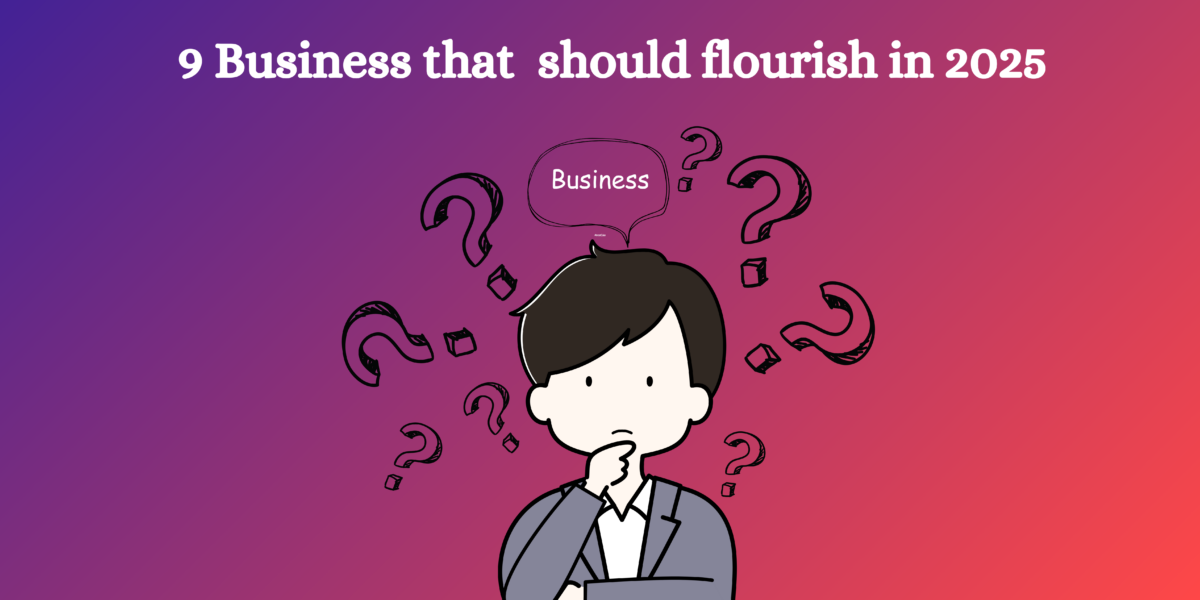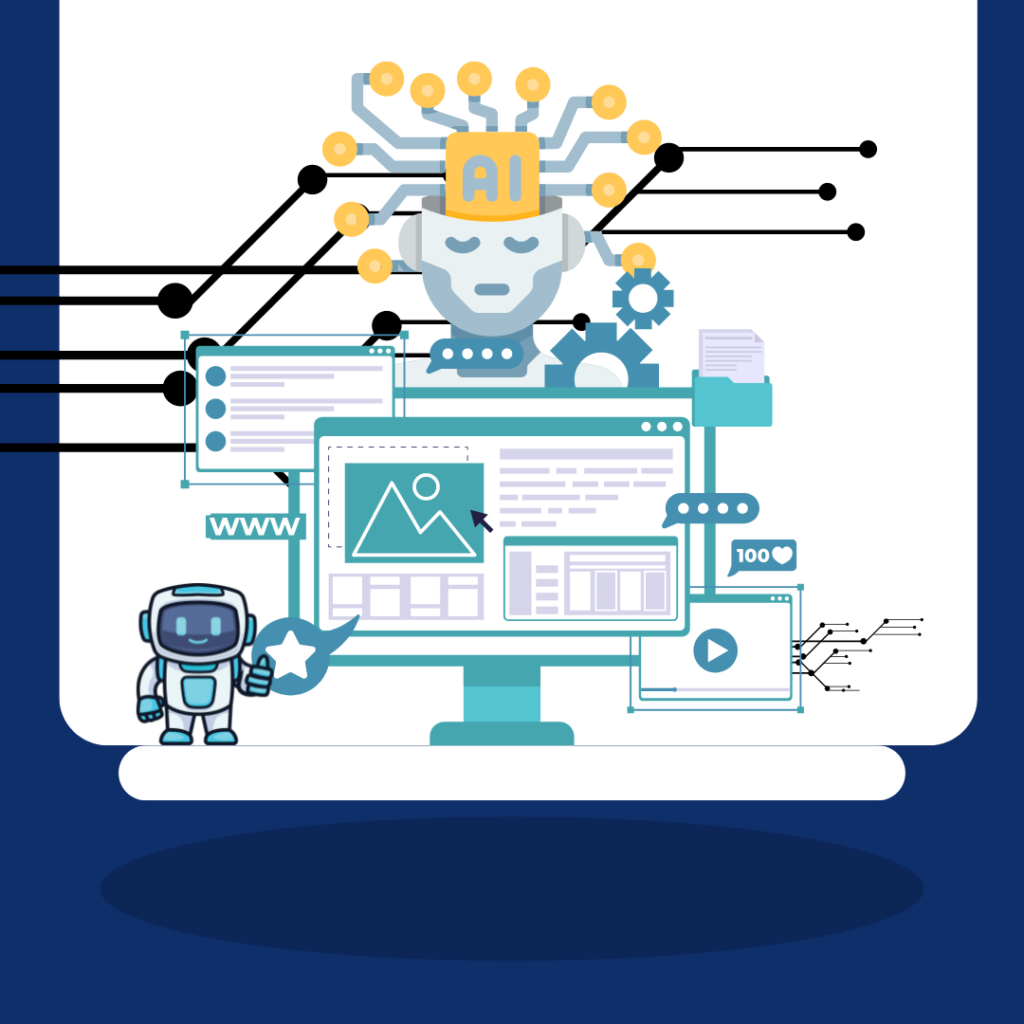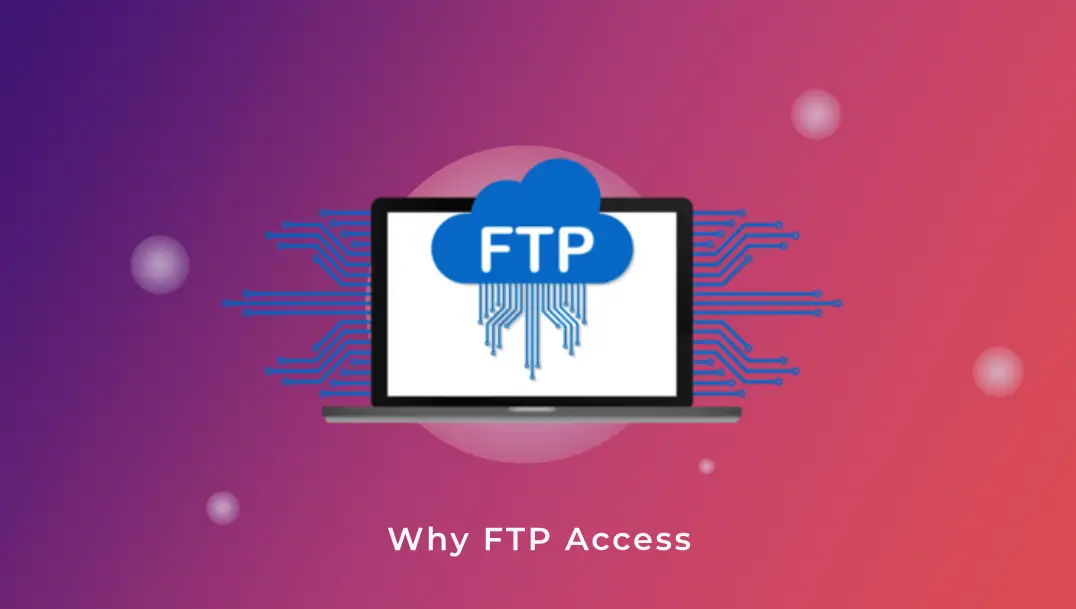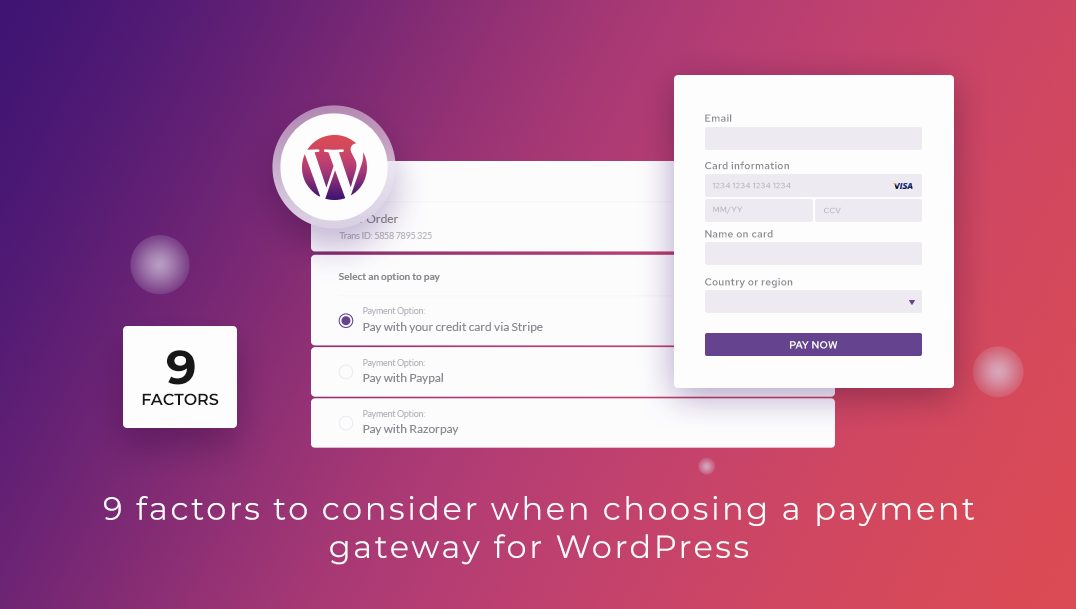In today’s rapidly evolving world, the business landscape is in a state of constant flux, driven by technological advancements, shifting consumer preferences, and emerging societal needs. As we look ahead to 2025, it’s clear that certain business sectors are poised to thrive, thanks to their innovative approaches and the way they address current and future demands. Whether it’s leveraging technology to enhance convenience, promoting sustainability, or catering to the changing dynamics of the workforce and healthcare, these businesses are set to flourish in the coming years. As Richard Branson once said –
“Business opportunities are like buses, there’s always another one coming ”
– Richard Branson
In this blog, we’ll explore 9 business ideas that show tremendous promise for 2025. These aren’t just passing trends; they represent significant shifts in how we live, work, and interact with the world around us. By understanding and investing in these areas, you may discover your own business idea and position yourself for long-term success. From the rise of cloud kitchens to the integration of physical and digital experiences, and sustainable energy solutions to the burgeoning field of telehealth, each of these business ideas offers unique opportunities to innovate and grow.
So, let’s dive in and take a closer look at why these nine businesses should flourish in 2025, and what makes them stand out in an ever-changing market.
Electric Vehicle(EV) and Charging Infrastructure
The shift towards electric vehicles (EVs) represents one of the most transformative changes in the automotive industry today. As the world becomes increasingly aware of the detrimental effects of climate change and air pollution, EVs offer a cleaner, more sustainable alternative to traditional gasoline-powered cars. This transition is not just an environmental imperative but also a lucrative business opportunity, both in the realm of EV manufacturing and the development of the critical charging infrastructure to support them.
The demand for electric vehicles is on a steady rise, driven by a combination of environmental concerns, regulatory pressures, and advancements in technology. Consumers are becoming more environmentally conscious, seeking ways to reduce their carbon footprint, and EVs provide a compelling solution. Governments worldwide are also playing a significant role in this shift by introducing stringent emissions regulations and offering substantial incentives for both manufacturers and consumers. These incentives, which range from tax credits to rebates and grants, make EVs more affordable and attractive to a broader audience.

Technological advancements in electric vehicles are also propelling the industry forward. Innovations in battery technology have significantly improved the range, performance, and cost-efficiency of EVs. Lithium-ion batteries have become more energy-dense, extending the distance EVs can travel on a single charge while emerging technologies like solid-state batteries promise even greater improvements. Additionally, the development of fast-charging technology is addressing one of the primary concerns potential EV buyers have: charging time. With fast chargers, EVs can be recharged in a fraction of the time it used to take, making them more convenient for everyday use.
However, the success of electric vehicles hinges not just on the vehicles themselves but also on the availability and accessibility of charging infrastructure. As more consumers make the switch to EVs, the demand for convenient, reliable charging stations is growing exponentially. This presents a significant business opportunity for companies involved in the development and deployment of EV charging infrastructure. Building a network of charging stations in urban areas, along highways, and in rural regions is essential to support the widespread adoption of EVs. Companies that can establish a robust and accessible charging network stand to benefit greatly as the market expands.
Investing in EV charging infrastructure is a strategic move for businesses looking to capitalize on the green transportation revolution. It not only supports the growth of the EV market but also offers a steady revenue stream through charging fees and subscription models. Moreover, as the adoption of EVs increases, partnerships with automotive manufacturers, government bodies, and real estate developers will create additional business opportunities, making the EV charging infrastructure sector a cornerstone of the future automotive landscape.
In conclusion, the transition to electric vehicles and the corresponding need for comprehensive charging infrastructure present a golden opportunity for businesses. As technology continues to advance and consumer demand for sustainable transportation grows, investing in EVs and their charging networks is not just a smart business move but also a crucial step towards a greener, more sustainable future. The journey towards widespread EV adoption is well underway, and those who get on board now will be well-positioned to lead the charge into a cleaner, more efficient automotive era.
EdTech
“We need technology in every classroom and in every student and teacher’s hand, because it is the pen and paper of our time, and it is the lens through which we experience much of our world.”
– David Warlick
The landscape of education is undergoing a seismic shift, driven by technological innovation and the increasing demand for accessible, personalized learning experiences. EdTech, or educational technology, encompasses a wide array of tools and platforms designed to enhance the learning process. From online learning platforms to virtual classrooms, EdTech is reshaping how we acquire knowledge and skills.
The benefits of EdTech are manifold. For one, it democratizes education by making high-quality learning resources accessible to anyone with an internet connection. This is particularly impactful in regions where traditional educational infrastructure is lacking. Furthermore, EdTech platforms offer a level of flexibility that conventional education often can’t. Learners can access courses at their own pace, fitting education into their busy lives and allowing for a more personalized learning journey.
The pandemic has undoubtedly accelerated the adoption of EdTech. With schools and universities forced to pivot to online learning almost overnight, the potential of digital education became evident. But even as we move past the immediate impacts of the pandemic, the convenience and effectiveness of online education are likely to ensure its continued growth.
In 2025, EdTech is expected to thrive, driven by ongoing advancements in technology. Artificial intelligence and machine learning will further personalize the learning experience, offering tailored content and feedback to each student. Virtual and augmented reality will make learning more immersive and engaging, particularly in subjects that benefit from hands-on experience, such as science and engineering.
Additionally, the focus on lifelong learning and skill development will sustain the demand for EdTech. As the job market evolves, individuals will continually seek opportunities to upskill and reskill, turning to online platforms for affordable and flexible learning solutions. The ability of EdTech to adapt to the changing needs of both learners and educators positions it as a cornerstone of the future education landscape.
Subscription Services
Subscription services have quickly become a go-to business model for many industries, revolutionizing how we access and enjoy products and services. Whether it’s streaming your favorite shows on Netflix, receiving monthly beauty boxes, or getting meal kits delivered to your door, the subscription model offers convenience and value that traditional models often can’t match. Here’s a closer look at why this business approach is booming and why it’s such a smart strategy.

One of the biggest perks of subscription services is the steady and predictable revenue they provide. Unlike traditional sales, where income can be erratic and seasonal, subscriptions ensure a regular cash flow. This stability makes it easier for businesses to plan ahead, manage finances, and invest in growth initiatives. Instead of worrying about how to make ends meet during off-peak times, companies can focus on innovation and improving their offerings.
Subscriptions create a lasting relationship between the business and the customer. When someone subscribes to a service, they’re committing to a longer-term engagement. This ongoing connection helps build loyalty and keeps customers coming back. Happy subscribers are also more likely to spread the word, acting as brand ambassadors and driving organic growth. It’s a win-win: customers get continuous value, and businesses benefit from repeat business and referrals.
The subscription model is great for upselling and cross-selling. Once customers are subscribed, it’s easier to introduce them to additional services or premium upgrades. For instance, a streaming service might offer exclusive content for a higher subscription tier, or a meal kit company might provide special gourmet recipes. These extra options not only boost revenue but also enhance the overall customer experience, making them feel more valued and engaged.
With subscriptions, businesses gain a treasure trove of data about customer preferences and behaviors. This information is precious for refining products and tailoring marketing efforts. Companies can identify trends, predict future needs, and offer personalized experiences by analyzing how customers interact with their service. This level of customization keeps customers satisfied and reduces the likelihood of them canceling their subscriptions.
Subscription services are built for scalability. As the customer base grows, the cost of adding new subscribers is usually minimal compared to the revenue they bring in. This makes it easier for businesses to expand and boost profitability. Plus, subscriptions are flexible; companies can introduce new plans, bundle services, or offer special promotions to attract and retain customers. It’s a dynamic model that can adapt to changing market conditions and consumer demands.
Subscription businesses often enjoy lower customer acquisition costs (CAC). The recurring revenue from each subscriber helps offset the initial costs of acquiring them. Plus, the predictable income allows for more strategic and sustained marketing efforts. Instead of spending big on one-time sales campaigns, companies can invest in building long-term relationships, which tend to be more cost-effective in the long run.
In conclusion, the subscription service model is a powerhouse strategy that offers multiple advantages. Its ability to provide steady revenue, foster customer loyalty, offer upselling opportunities, and scale efficiently makes it a smart choice for businesses looking to thrive in today’s competitive market. As consumers continue to seek convenience and personalized experiences, the subscription model is poised to remain a major player in the business world.
Telehealth & Mental Wellness Services
The healthcare industry is undergoing a remarkable transformation, thanks to the rapid advancements in technology and the growing demand for accessible and convenient medical services. Telehealth, which refers to the use of digital communication technologies to provide healthcare services remotely, has emerged as a game-changer. Coupled with a heightened awareness of mental health issues, telehealth and mental wellness services are set to flourish in 2025.
Telehealth offers numerous benefits that traditional in-person consultations often can’t match. For one, it eliminates the need for travel, making healthcare accessible to people in remote or underserved areas. Patients can consult with their doctors from the comfort of their homes, reducing the time and cost associated with visits to healthcare facilities. This is particularly beneficial for individuals with mobility issues or those living in rural regions.
The convenience of telehealth also extends to mental wellness services. With the stigma around mental health slowly eroding, more people are seeking help for conditions such as anxiety, depression, and stress. Virtual therapy sessions make it easier for individuals to access mental health professionals, ensuring timely support without the added pressure of physically visiting a clinic. The anonymity and comfort of a home environment can also encourage more people to seek help.
Technology plays a crucial role in the effectiveness of telehealth services. Advances in video conferencing, secure data transmission, and remote monitoring tools ensure that patients receive high-quality care. Wearable devices that track vital signs and health metrics can provide doctors with real-time data, enabling more accurate diagnoses and personalized treatment plans. Additionally, AI-driven chatbots and virtual assistants can offer preliminary advice and support, streamlining the patient care process.
Looking ahead, the telehealth and mental wellness industry is poised for significant growth. As people become more accustomed to digital interactions, the demand for remote healthcare services will continue to rise. Furthermore, the integration of AI and machine learning will enhance the precision and efficiency of telehealth, providing even better outcomes for patients. Governments and healthcare providers are likely to continue investing in telehealth infrastructure, recognizing its potential to improve public health and reduce the burden on traditional healthcare systems.
Sustainable & Renewable Energy Solutions
The shift towards sustainable and renewable energy solutions is not just a trend; it is a necessity for the future of our planet. As concerns about climate change and environmental degradation grow, the demand for clean and renewable energy sources is escalating. In 2025, businesses that focus on sustainable and renewable energy solutions are expected to thrive, driven by technological advancements, supportive policies, and a growing public awareness of environmental issues.
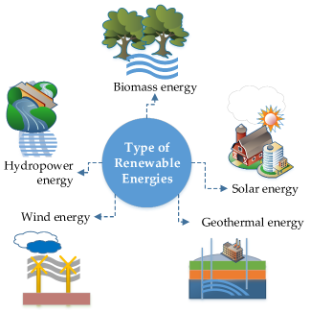
Renewable energy solutions such as solar, wind, and bioenergy offer significant advantages over traditional fossil fuels. They are abundant, sustainable, and produce little to no greenhouse gas emissions. Solar power, for instance, harnesses energy from the sun, providing a virtually inexhaustible source of energy. Similarly, wind turbines convert wind energy into electricity without any harmful emissions. These technologies are becoming more efficient and cost-effective, making them increasingly viable for widespread adoption.
One of the key drivers of the growth in renewable energy is the advancement in energy storage technologies. Batteries and other energy storage solutions are critical for addressing the intermittent nature of renewable energy sources. Innovations in this area are enabling the storage of excess energy generated during peak production times, which can then be used when production is low. This ensures a reliable and stable energy supply, overcoming one of the main challenges of renewable energy.
Government policies and incentives are also playing a vital role in promoting the adoption of renewable energy. Many countries are implementing regulations and offering subsidies to encourage businesses and households to switch to clean energy. These initiatives are creating a favorable environment for investment in renewable energy infrastructure and technologies. Additionally, international agreements and commitments to reduce carbon emissions are pushing nations to accelerate their transition to sustainable energy sources.
Consumer demand is another powerful force driving the growth of renewable energy. As people become more environmentally conscious, they are increasingly seeking out products and services that align with their values. Businesses that can demonstrate their commitment to sustainability are likely to attract a loyal customer base. Moreover, adopting renewable energy can significantly reduce operational costs in the long run, making it a financially sound decision for businesses.
In conclusion, the future looks bright for sustainable and renewable energy solutions. The combination of technological innovation, supportive policies, and rising consumer awareness is creating a robust market for clean energy. By investing in renewable energy, businesses can not only contribute to a healthier planet but also position themselves for long-term success in an evolving energy landscape. As we move towards 2025, the transition to sustainable energy sources will be a key driver of economic growth and environmental sustainability.
IoT: Smart Homes & Connected Devices
“If you think that the internet has changed your life, think again. The Internet of Things is about to change it all over again!”
– Brendan O’Brien
The Internet of Things (IoT) revolutionizes how we interact with our homes and devices, creating a seamlessly connected environment that enhances convenience, efficiency, and security. By 2025, the proliferation of smart homes and connected devices will transform our daily lives in ways we could only imagine a few years ago.
Smart homes leverage IoT technology to connect various devices and systems, allowing them to communicate with each other and with us. This interconnectedness enables a level of automation and control that simplifies household management and enhances our living experience. Imagine waking up in the morning to your smart alarm clock, which has already communicated with your coffee maker to start brewing your favorite blend. Your smart thermostat adjusts the temperature based on your preferences, while your smart lights gradually brighten to simulate a natural sunrise.
One of the most significant benefits of smart homes is the improvement in energy efficiency and cost savings. Smart thermostats learn your schedule and adjust the heating or cooling accordingly, ensuring optimal energy use. Smart lighting systems automatically turn off lights when rooms are unoccupied, and smart appliances operate during off-peak hours to reduce energy costs. These features not only lower utility bills but also contribute to a more sustainable lifestyle.
Security is another critical aspect of smart homes. Connected security cameras, doorbell cameras, and smart locks provide real-time monitoring and control, enhancing the safety of our homes. You can receive alerts on your smartphone if unusual activity is detected, and remotely lock or unlock doors for visitors. These technologies give homeowners peace of mind, knowing that their homes are secure even when they are away.
The growth of IoT and smart homes is fueled by continuous advancements in technology and increasing consumer demand for convenience and efficiency. Companies are investing heavily in developing more sophisticated and user-friendly devices. The integration of artificial intelligence and machine learning further enhances the capabilities of smart home systems, allowing for more intuitive and personalized experiences.
As we move towards 2025, the adoption of smart homes and connected devices will continue to rise. The convenience, efficiency, and security they offer are too compelling to ignore. For businesses and consumers alike, embracing IoT technology represents a step towards a more connected and intelligent future.
Co-working Spaces & On-Demand Services
The way we work is evolving rapidly, driven by the rise of the gig economy, remote work, and the increasing need for flexibility. Co-working spaces and on-demand services are at the forefront of this transformation, offering innovative solutions that cater to the diverse needs of modern professionals.
Co-working spaces provide a flexible and collaborative environment for freelancers, startups, and remote workers. Unlike traditional office spaces, co-working spaces offer short-term memberships and the flexibility to choose from various workstations, private offices, or meeting rooms. This flexibility is particularly appealing in today’s fast-paced world, where the nature of work can change rapidly.
One of the main attractions of co-working spaces is the sense of community they foster. These spaces bring together individuals from different industries and backgrounds, creating opportunities for networking, collaboration, and knowledge sharing. The collaborative atmosphere can spark creativity and innovation, providing a supportive environment for entrepreneurs and small businesses to thrive.
In addition to physical workspaces, the rise of on-demand services is reshaping how we manage our work and personal lives. On-demand services offer convenience and efficiency by providing instant access to a wide range of services, from transportation and food delivery to administrative support and technical assistance. For busy professionals, these services are invaluable, allowing them to focus on their core tasks while outsourcing non-essential activities.
Technology plays a crucial role in the success of co-working spaces and on-demand services. Advanced booking systems, high-speed internet, and digital collaboration tools are essential features of modern co-working spaces. Meanwhile, mobile apps and platforms enable seamless access to on-demand services, making it easy for users to request and receive services with just a few taps on their smartphones.
As we approach 2025, the demand for co-working spaces and on-demand services is expected to grow. The flexibility and convenience they offer align with the changing nature of work and the increasing desire for work-life balance. Companies and individuals are recognizing the benefits of these solutions, leading to a surge in investment and innovation in this sector.
In conclusion, co-working spaces and on-demand services are redefining the future of work. They provide the flexibility, community, and convenience that modern professionals seek, making them an integral part of the evolving work landscape. As we continue to embrace new ways of working, these solutions will play a pivotal role in supporting productivity, creativity, and overall well-being.
Homecare to the Elderly
As the global population ages, the demand for quality homecare services for the elderly is becoming increasingly critical. By 2025, the homecare industry is expected to flourish, driven by advancements in healthcare technology, changing family dynamics, and a growing preference for aging in place. Homecare services provide essential support to the elderly, allowing them to maintain their independence and quality of life within the comfort of their own homes.
Source:- JSS Hospitals
One of the primary drivers of the growth in home care is the demographic shift towards an older population. With people living longer, there is a rising need for long-term care solutions that can accommodate the unique needs of the elderly. Homecare services offer a wide range of support, from medical care and physical therapy to assistance with daily activities such as bathing, dressing, and meal preparation. This personalized care helps seniors live more comfortably and safely in their own homes.
Advancements in healthcare technology are also transforming homecare services. Telehealth and remote monitoring tools enable healthcare providers to track patients’ health conditions in real-time, providing timely interventions and reducing the need for frequent hospital visits. Wearable devices can monitor vital signs, detect falls, and alert caregivers in case of emergencies, ensuring continuous care and peace of mind for both seniors and their families.
Moreover, the growing recognition of the importance of mental and emotional well-being in the elderly population is leading to a more holistic approach to homecare. Services are expanding to include companionship, mental health support, and activities that promote cognitive function and social engagement. These elements are crucial for combating loneliness and depression, common issues among the elderly.
The homecare industry is also benefiting from a shift in family dynamics. With more dual-income households and geographically dispersed families, there is an increasing reliance on professional caregivers to provide the necessary support for aging relatives. Homecare services offer a practical solution, enabling families to ensure their loved ones receive quality care without sacrificing their own work and personal commitments.
In conclusion, homecare for the elderly is set to thrive in 2025, driven by demographic trends, technological advancements, and evolving family needs. By providing comprehensive, personalized care, homecare services enable seniors to age with dignity and independence, enhancing their overall quality of life. As the demand for these services continues to grow, the homecare industry will play a vital role in supporting our aging population.
Big Data Analytics & AI-powered Solutions
In today’s digital age, data is often referred to as the new oil, and for good reason. Big data analytics and AI-powered solutions are transforming industries by enabling businesses to make data-driven decisions, optimize operations, and innovate like never before. By 2025, these technologies are expected to be even more integral to business success, driving growth and competitiveness across various sectors.
Big data analytics involves the process of examining large and complex data sets to uncover hidden patterns, correlations, and insights. This capability is invaluable for businesses seeking to understand customer behavior, market trends, and operational inefficiencies. By leveraging big data, companies can gain a deeper understanding of their audience, allowing for more targeted marketing, improved product development, and enhanced customer experiences.
AI-powered solutions take big data analytics to the next level by incorporating artificial intelligence and machine learning. These technologies can analyze data at unprecedented speeds and accuracy, providing predictive insights and automating decision-making processes. For instance, AI algorithms can predict customer preferences and behaviors, enabling businesses to offer personalized recommendations and services. In manufacturing, AI can optimize supply chains, reduce downtime through predictive maintenance, and improve overall production efficiency.
The healthcare industry is one of the sectors most profoundly impacted by big data and AI. Through the analysis of medical records, genetic data, and real-time health monitoring, AI-powered solutions can assist in diagnosing diseases, predicting outbreaks, and personalizing treatment plans. This leads to better patient outcomes and more efficient healthcare delivery. Similarly, in finance, AI-driven analytics can detect fraudulent activities, assess credit risks, and provide personalized financial advice.
Moreover, the integration of big data and AI is driving innovation in smart cities, where data from various sources, such as traffic sensors, energy grids, and public services, is analyzed to improve urban living. AI can optimize traffic flow, enhance public safety, and manage resources more efficiently, creating more sustainable and livable cities.
The rise of big data analytics and AI-powered solutions is also fostering a culture of continuous improvement and innovation. Businesses are increasingly adopting these technologies to stay competitive, leading to a surge in investment in AI research and development. As AI becomes more advanced and accessible, its applications will continue to expand, offering new opportunities for businesses to innovate and grow.
In conclusion, big data analytics and AI-powered solutions are revolutionizing how businesses operate and make decisions. By harnessing the power of data and artificial intelligence, companies can gain actionable insights, drive efficiency, and create more personalized experiences for their customers. As we look towards 2025, the integration of these technologies will be crucial for business success, opening up new possibilities and transforming industries across the board.
Conclusion
By 2025, the business landscape will be revolutionized by innovative solutions that address our changing needs and challenges. The shift towards electric vehicles (EVs) and the rise of EdTech will reshape transportation and education, while the integration of physical and digital experiences will transform retail and entertainment. Home care for the elderly will become more essential, supported by advancements in telehealth. The push for sustainable energy, the rise of smart homes, and the sophistication of AI-powered analytics will further define the future of commerce and daily life. Embracing these advancements will open up a world of endless possibilities.
For MultiVendorX users, understanding these trends is more than just insightful—it’s essential. Recognizing the potential of these innovations can help you discover new business ideas and stay ahead of the competition. Whether it’s using AI to improve customer experiences, adopting sustainable energy to cut costs, or diving into the booming EdTech sector, the opportunities are immense.
MultiVendorX is here to help you navigate this journey. Our platform offers the tools and resources you need to implement these trends in your business. With detailed market analysis and expert advice on adopting new technologies, MultiVendorX provides the support you need to succeed.
And while AI might help you find your next favorite meal or save on energy bills, it can’t take out the trash—at least not yet! With MultiVendorX by your side, you can focus on what truly matters: growing your business and seizing the future’s endless possibilities. Explore our platform today and start turning these trends into real success.
And remember, while AI might help you find your next favorite meal or save on energy bills, it still can’t take out the trash—at least not yet!

